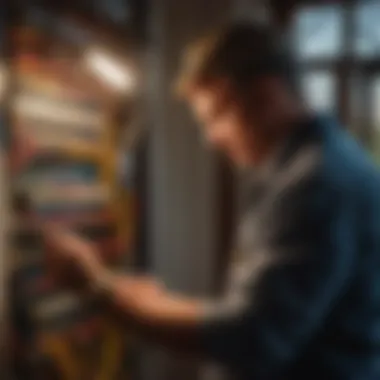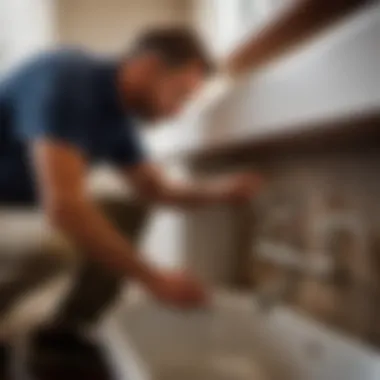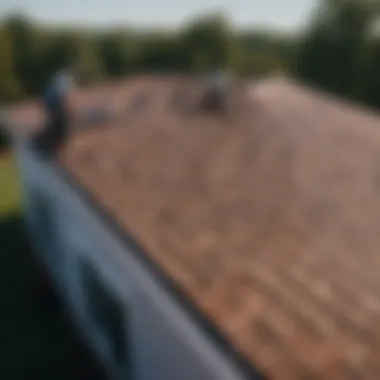Materials:
- Measuring tape: Ensure precise measurements with a reliable measuring tape, preferably with both metric and imperial measurements for accuracy.
- Level: A level tool is crucial to guarantee that surfaces are straight and even during the inspection process.
- Flashlight: Adequate illumination is necessary for examining dark or hard-to-reach areas within the property.
- Screwdriver set: Having a set with various sizes and types of screwdrivers will facilitate the inspection of fixtures and fittings.
- Pen and notepad: Essential for documenting observations during the inspection for reference and record-keeping.
DIY Steps:
- Prepare by gathering all necessary materials and tools listed above before commencing the inspection process.
- Begin the inspection from the exterior of the property, assessing the foundation, walls, windows, doors, and overall structure for any visible damage or wear.
- Move on to inspecting the interior, focusing on electrical systems, plumbing fixtures, HVAC units, and other essential components.
- Record detailed notes and observations as you progress through each area of the property to ensure a thorough evaluation.
- Conclude the inspection by reviewing all findings and preparing a comprehensive report detailing the condition of the property.
Technical Aspects:
- Timing specifics: Allocate sufficient time for the inspection to ensure a detailed evaluation without rushing through any critical areas.
- Tools: Utilize a ladder for accessing high or elevated spaces, a moisture meter to detect water damage, and a circuit tester for electrical assessments.
- Critical techniques: Employ thermal imaging to identify hidden issues, perform air quality tests for indoor environments, and use a borescope for inspecting narrow or obstructed areas.
DIY Project Process:


- Begin by examining the property's exterior, paying close attention to the foundation for cracks, the siding for moisture damage, and the roof for missing shingles or signs of leaks.
- Proceed to check the interior, testing the electrical outlets for functionality, examining plumbing fixtures for leaks or corrosion, and inspecting the HVAC system for proper operation.
- Address any issues encountered during the inspection process promptly, utilizing troubleshooting tips such as checking for tripped circuit breakers, sealing leaky pipes, or replacing malfunctioning light fixtures.
- Conclude the inspection by compiling a detailed report outlining all findings, recommendations for repairs or maintenance, and any additional observations that may impact the property's overall condition.
Introduction


In the realm of homeownership, a pivotal yet often overlooked aspect is the home inspection process. This comprehensive guide delves into the intricate details that encapsulate what a home inspector checks during an inspection. The significance of this topic cannot be overstated, as it serves as the bedrock for making informed decisions about a property. Understanding the depth and breadth of a home inspection not only ensures the longevity and safety of a dwelling but also provides peace of mind to potential homeowners and sellers.
Furthermore, a thorough examination conducted by a professional home inspector can unveil hidden issues that may not be apparent to an untrained eye. From structural deficiencies to faulty electrical systems, each component assessed during an inspection contributes to a holistic evaluation of a property's condition. By shedding light on the intricacies of a home inspection, individuals can navigate the real estate landscape with confidence and foresight.
Purpose of a Home Inspection
A paramount objective of a home inspection is to assess the overall condition and functionality of a property. It serves as a comprehensive evaluation aimed at identifying existing problems and potential issues that could arise in the future. Through a methodical examination of various systems and structures, home inspectors aim to provide a detailed report outlining the property's strengths and vulnerabilities.
Moreover, a home inspection empowers both buyers and sellers with valuable information that can guide their decisions. For buyers, it ensures they are making a sound investment by uncovering any underlying issues that may require attention. Sellers, on the other hand, can address identified issues proactively, thus enhancing the marketability of their property. Ultimately, the purpose of a home inspection is to instill confidence and transparency in real estate transactions, fostering a sense of trust and assurance among all parties involved.
Importance of Hiring a Professional Home Inspector
As the cornerstone of a successful home inspection, the role of a professional home inspector cannot be overstated. Their expertise and experience bring a level of precision and thoroughness to the evaluation process, ensuring no stone is left unturned. By engaging the services of a qualified home inspector, individuals can benefit from a meticulous assessment that goes beyond surface-level observations.
Professional home inspectors possess a keen eye for detail and a comprehensive understanding of building codes and standards. They are equipped with specialized tools and knowledge that enable them to identify potential issues that may evade the untrained observer. By entrusting the inspection to a qualified professional, individuals can rest assured that they are receiving an unbiased and comprehensive evaluation of the property's condition.
Furthermore, hiring a professional home inspector is a proactive step towards safeguarding one's investment in real estate. Their insights and recommendations can help individuals make informed decisions regarding repairs, maintenance, and negotiations. In a competitive real estate market, the expertise of a professional home inspector can provide a significant advantage, allowing individuals to navigate the complexities of property transactions with clarity and confidence.
Exterior Inspection


The exterior inspection is a crucial aspect of the overall home inspection process as it provides a detailed assessment of the outer components of a property. This section of the comprehensive guide is vital in ensuring thorough scrutiny of the home's exterior features, helping to identify any potential issues or concerns that may impact the property's safety and integrity. By thoroughly examining the exterior elements, including the roof, walls, and foundation, a professional home inspector can offer valuable insights into the overall condition of the property.
Roof and Attic
Roofing Materials
Roofing materials play a pivotal role in protecting a home from external elements, such as rain, wind, and snow. The choice of roofing material significantly impacts the durability and longevity of the roof, making it a critical consideration during a home inspection. Common roofing materials like asphalt shingles, metal, and tile each have unique characteristics that contribute to their overall performance. For example, asphalt shingles are popular for their cost-effectiveness and ease of installation, while metal roofs offer exceptional durability and energy efficiency. Understanding the advantages and disadvantages of different roofing materials is essential for homeowners to make informed decisions regarding roof maintenance and repairs.
Gutters and Downspouts
Gutters and downspouts are essential components of a home's drainage system, directing rainwater away from the foundation to prevent water damage. Properly functioning gutters and downspouts help protect the exterior walls, landscaping, and foundation from moisture issues and structural damage. Regular inspection of these elements is crucial to ensure they are free from debris, clogs, and damage that could impede water flow and lead to potential water-related issues within the property.
Chimneys
Chimneys play a significant role in ensuring the safe operation of fireplaces and wood-burning stoves within a home. During a home inspection, the chimney is inspected for signs of damage, such as cracks, deterioration, or obstruction. Proper ventilation and structural integrity of the chimney are essential for preventing fire hazards and maintaining indoor air quality. Understanding the unique features and maintenance requirements of chimneys is fundamental in preserving their functionality in residential properties.
Interior Inspection
In this article, the Interior Inspection section holds paramount significance as it delves into the crucial elements of a property that are often hidden from plain sight. When it comes to evaluating a home's overall condition, the interior aspects play a vital role in determining its functionality, safety, and comfort. A meticulous inspection of the plumbing, electrical, and HVAC systems inside a property provides invaluable insights into the home's inner workings. By focusing on the Interior Inspection, readers can grasp the intricate details that contribute to a comprehensive evaluation of a property's overall health and livability.
Plumbing System
Pipes and Drains
Pipes and Drains form the backbone of a property's plumbing system, carrying water in and out of the house efficiently. The specific aspect of Pipes and Drains that deserves attention is their structural integrity and functionality. The key characteristic of well-installed and maintained Pipes and Drains lies in their ability to prevent leaks, clogs, and water damage. Home inspectors often look for corrosion, blockages, and proper venting to ensure a smooth flow of water throughout the property. The advantage of having high-quality Pipes and Drains is evident in the reduced risk of water-related issues, ensuring the longevity and efficiency of the plumbing system.
Water Heater
The Water Heater plays a vital role in providing hot water for various household activities, from showering to dishwashing. Highlighting the key characteristic of a Water Heater involves its energy efficiency, heating capacity, and safety features. A properly functioning Water Heater can significantly enhance the comfort and convenience of residents. Inspectors check for sediment buildup, leaks, and proper venting to assess the Water Heater's performance. The unique feature of tankless Water Heaters lies in their on-demand hot water supply, saving energy and space. While traditional tank Water Heaters offer a reservoir of hot water for consistent usage, they may occupy more space. Understanding the advantages and disadvantages of different Water Heater types aids in making informed decisions regarding efficient water heating solutions.
Fixtures
Fixtures such as faucets, sinks, showers, and toilets play a crucial role in the overall functionality and aesthetics of a property's plumbing system. The key characteristic of high-quality Fixtures lies in their durability, water efficiency, and design. Home inspectors focus on inspecting fixtures for leaks, proper sealing, and efficient water flow. Choosing Fixtures that are WaterSense certified can lead to water savings and reduced utility bills. The unique feature of modern fixtures includes touchless technology, water-saving features, and elegant designs that enhance the property's appeal. Understanding the advantages and disadvantages of different fixture materials and styles helps homeowners select fixtures that meet their preferences and conservation goals.
Electrical System
The Electrical System section of this article sheds light on the critical components that power a home's electrical infrastructure. From wiring to outlets and switches, each aspect of the electrical system plays a significant role in providing safe and reliable electricity throughout the property
Follow the same detailed format for the remaining subsections under Electrical System and HVAC System as outlined in the requirements.
Structural Inspection
In this section, we delve into the crucial aspect of structural inspection which plays a pivotal role in evaluating the overall condition and safety of a property. Structural inspection is a fundamental part of any home inspection process as it enables inspectors to assess the integrity of the building's framework. By conducting a detailed structural inspection, potential issues and risks can be identified, allowing for necessary repairs and maintenance to be implemented promptly.
Structural inspection encompasses a thorough examination of various components such as the foundation, beams, columns, and crawl spaces. The goal is to ensure that the structural elements are sound and stable to support the property adequately. This assessment provides homeowners with valuable insights into the structural health of their home, addressing any potential safety hazards and structural deficiencies.
Foundation
When focusing on the foundation during a home inspection, inspectors pay particular attention to two key aspects: cracks and settlement. These indicators can reveal underlying structural issues that may impact the stability and durability of the building.
Cracks
Cracks in the foundation are a common concern during inspections as they can signify shifts in the soil, water damage, or structural stress. It is crucial to analyze the size, location, and direction of cracks to determine their severity and potential impact on the overall structure. While minor hairline cracks might be insignificant, larger or widening cracks could indicate significant structural movement or settlement.
Inspectors note the patterns of cracks, whether they are horizontal, vertical, or diagonal, to assess the type of stress the foundation is experiencing. Understanding the nature of the cracks helps in identifying the underlying cause and formulating effective remediation strategies. Addressing foundation cracks promptly is essential to prevent further damage and ensure the stability of the property.
Settlement
Settlement refers to the gradual sinking or shifting of a building's foundation over time. It is a critical issue that can lead to uneven floors, leaning walls, and structural instability. During an inspection, inspectors use various tools and techniques to measure and evaluate the degree of settlement present in the foundation.
Inspectors look for signs of settlement such as gaps between walls and floors, sloping or uneven surfaces, and misaligned doors or windows. These indicators suggest the extent of foundation settlement and help inspectors make informed recommendations for repair and reinforcement. Addressing foundation settlement early is essential to prevent further structural damage and ensure the long-term stability of the building.
Beams and Columns
Beams and columns are integral structural components that provide support and stability to a building's framework. During a home inspection, inspectors assess the condition of beams and columns to identify any signs of deterioration, damage, or rot that may compromise the structural integrity of the property.
Wood Damage
Wood damage in beams and columns can result from moisture intrusion, insect infestation, or prolonged exposure to environmental elements. Inspectors examine the extent of wood damage, including rot, decay, or weakening of structural beams and columns. Understanding the nature and severity of wood damage is essential to determine the appropriate repair or replacement measures required to ensure structural stability.
Rot
Rot is a common issue that affects wooden beams and columns, especially in areas susceptible to moisture or humidity. Rot compromises the strength and durability of the wood, leading to structural weakness and potential safety hazards. Inspectors identify signs of rot through visual inspections, probing techniques, and moisture meters to assess the extent of decay and deterioration.
Inspectors evaluate the type of rot present, whether it is dry rot or wet rot, to determine the underlying cause and develop targeted solutions for remediation. Addressing wood rot promptly is essential to prevent further deterioration and ensure the structural integrity of the building.
Crawl Spaces
Crawl spaces play a significant role in supporting a building's foundation and providing access to essential utilities such as plumbing and electrical systems. During a home inspection, inspectors thoroughly examine crawl spaces to assess for moisture issues, insulation quality, ventilation, and potential pest infestations.
Inspectors inspect the condition of crawl space foundations, looking for signs of moisture intrusion, mold growth, or structural damage. Proper ventilation and insulation are crucial elements that impact the overall indoor air quality and energy efficiency of the property. Additionally, inspectors check for any evidence of pest infestations or wood-destroying organisms that could undermine the structural integrity of the building.
Ensuring the optimal condition of crawl spaces through effective moisture management, insulation maintenance, and pest control measures is essential to safeguard the structural integrity and longevity of the property.
Additional Inspections
When it comes to a home inspection, additional inspections beyond the standard checks play a crucial role in assessing the overall condition of a property. These extra inspections provide a deeper level of scrutiny, focusing on specific elements that may not be covered in the primary assessment. By including additional inspections in the overall evaluation process, homeowners can gain a more comprehensive understanding of any potential issues that may impact the property's value and safety.
One of the primary benefits of incorporating additional inspections is the ability to uncover hidden problems that could go unnoticed during a routine inspection. For instance, tests for radon, mold, and termites delve into specific areas of concern that require specialized expertise. By conducting these targeted inspections, homeowners can address potential health hazards, structural weaknesses, or pest infestations that might otherwise be overlooked.
Furthermore, additional inspections can offer peace of mind to homeowners by providing detailed insights into aspects of the property that are not typically covered in a standard inspection. This enhanced level of scrutiny helps ensure that no stone is left unturned, leading to a thorough assessment that can guide future maintenance and renovation decisions.
However, it's essential for homeowners to consider the costs and time implications of these additional inspections. While they can offer valuable information, they also add to the overall expenses and timeline of the inspection process. Therefore, it's important to weigh the benefits of extra scrutiny against the practical aspects of conducting multiple inspections.





